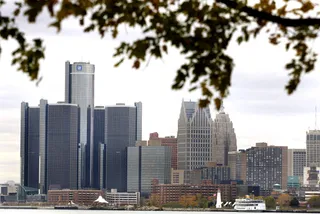Black Exodus: American Cities Losing African-American Residents
A look at decreased Black population in major cities.

1 / 8
Black Exodus - On a recent visit to Everett Middle School in San Francisco, Secretary of Housing and Urban Development Shaun Donovan spoke to a 12-year-old girl who described how an influx of white residents was decreasing the number of Blacks in her neighborhood. The young student highlighted the African-American population decreases plaguing major cities across America. Take a look at other cities that have suffered a decline in Black residency. —Dominique Zonyéé(Photo: Justin Sullivan/Getty Images)

2 / 8
San Francisco - San Francisco, once the home to Fillmore and other thriving Black middle-class neighborhoods, has seen the steepest decline in Black population than any other U.S. city. According to census data, the Black population plunged from 13.4 percent of city residents in 1970 to 6.5 percent in 2005. The African-American population continued to decline reaching 6.1 percent in 2012.(Photo: Ezra Shaw/Getty Images)

3 / 8
Washington, D.C. - The nation’s capital had a Black majority population for decades, but by 2011 D.C.’s African-American population had dropped more than 11 percent in a decade. According to 2011 data, the district's Black population is now about 301,000 — slightly more than half of its population. (Photo: TexPhoto/Getty Images)

4 / 8
Detroit - As a result of the auto bailout, the Motor City saw a decrease in overall population of 25 percent. It was the largest percentage loss for any American city with more than 100,000 residents over the last decade. In all, the city lost more than 237,000 residents, including 185,000 Blacks and about 41,000 whites.(Photo: Bill Pugliano/Getty Images)
Photo By Bill Pugliano/Getty Images

5 / 8
Oakland - Oakland, which has one of the nation’s largest African-American populations, also lost 25 percent of its Black population, a net loss of 33,000 African-American residents by 2011. Those drastic demographical changes led the city to have almost as many whites as it does Blacks.(Photo: NASA/LANDOV)
ADVERTISEMENT

6 / 8
Chicago - Oakland, which has one of the nation’s largest African-American populations, also lost 25 percent of its Black population, a net loss of 33,000 African-American residents by 2011. Those drastic demographical changes led the city to have almost as many whites as it does Blacks.(Photo: Scott Olson/Getty Images)

7 / 8
New York - New York City has the largest Black population of any city in the United States at close to 3.5 million. According to the 2010 U.S Census, Brooklyn had a Black population of 896,165, a drop from 939,316, according to the 2000 Census. Considered the center for African-American culture, Harlem’s is no longer a majority-Black neighborhood.(Photo: AP Photo/Mark Lennihan)
